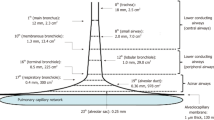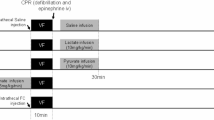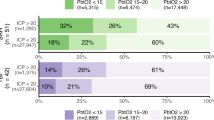Abstract
Newborn and 1-mo-old swine were exposed to identical durations (18 min) and degrees of hypoxia (O2 content = 4 mL/dL), to examine the effects of hypoxia on cerebral energy metabolism and intracellular pH (pHi)in vivo, using 31P and 1H nuclear magnetic resonance spectroscopy. Hypoxia produced the same extent of reductions in phosphocreatine (PCr) (63 ± 28% and 65 ± 10%, newborns and 1-mo-olds, respectively) and pHi (6.93 ± 0.06 and 6.89 ± 0.06, respectively) for either age group. The magnitude of changes in PCr, lactate, and pHi was larger for subgroups of data collected when cardiovascular instability was present, suggesting that hypotension and possibly reduced cerebral perfusion contributed to cerebral energy failure and lacticacidosis for either age group. There were no correlations between the blood plasma glucose concentration at 18 min of hypoxia and the extent of change in PCr, lactate, or pHi for either age group. During a subsequent period of complete ischemia induced via cardiac arrest after 20 min hypoxia, the decline in PCr and nucleoside triphosphate (NTP), and increase in lactate followed similar rates compared with previously studied age-matched animals that were normoxic before ischemia. The rate constants for the change in PCr, NTP, and lactate during ischemia showed no correlation with the blood plasma glucose concentration measured immediately before cardiac arrest. These results suggest that cerebral glycolytic rates and energy utilization during ischemia are unaffected by a preceding interval of hypoxia and that hyperglycemia does not delay cerebral energy failure during hypoxia or combined hypoxic-ischemia.
Similar content being viewed by others

Log in or create a free account to read this content
Gain free access to this article, as well as selected content from this journal and more on nature.com
or
Abbreviations
- AGR:
-
initial agonal glycolytic rate during complete ischemia
- Fio2:
-
fraction of inspired oxygen
- [glucose]plasma:
-
arterial blood plasma glucose concentration
- HR:
-
heart rate
- 1H NMR:
-
proton nuclear magnetic resonance
- klac:
-
first order rate constant for lactate accumulation
- Km:
-
blood plasma glucose concentration where glycolytic rate is half-maximal
- [lactate]final:
-
final postmortem brain lactate concentration
- [lactate]hypoxia:
-
brain lactate concentration at the end of hypoxia
- [lactate]plasma:
-
blood plasma lactate concentration
- MAP:
-
mean arterial blood pressure
- O2con:
-
blood oxygen content
- PCr:
-
phosphocreatine
- Pi:
-
inorganic phosphate
- Vmax:
-
maximum initial agonal glycolytic rate during complete ischemia
- FID:
-
free induction decay
- NTP:
-
nucleoside triphosphate
- pHa:
-
arterial pH
- pHi:
-
intracellular pH
References
Volpe JJ 1987 Hypoxic-ischemic encephalopathy: basic aspects and fetal assessment. In: Volpe JJ (ed) Neurology of the Newborn. WB Saunders, Philadelphia, 160–195.
Goplerud JM, Delivoria-Papadopoulos M 1993 Nuclear magnetic resonance imaging and spectroscopy following asphyxia. Clin Perinatol 20: 345–367.
Siesjö BK 1988 Acidosis and ischemic brain damage. Neurochem Pathol 9: 31–88.
Corbett RJT Corbett RJT 1990 In vivo multinuclear magnetic resonance spectroscopy investigations of cerebral development and metabolic encephalopathy using neonatal animal models. Semin Perinatol 14: 258–271.
McGowan JE, Marro PJ, Mishra OP, Delivoria-Papadopoulos M 1995 Brain cell membrane function during hypoxia in hyperglycemic newborn piglets. Pediatr Res 37: 133–139.
Silvia AL, Seidler FJ, Slotkin TA 1989 Effect of transient hypoxia on oxygenation of the developing rat brain: relationships among haemoglobin saturation, autoregulation of blood flow and mitochondrial redox state. J Dev Physiol 12: 287–292.
Corbett RJT, Laptook AR, Garcia D, Ruley JI 1993 Energy reserves and utilization rates in developing brain measured in vivo by 31P and 1H nuclear magnetic resonance spectroscopy. J Cerebral Blood Flow Metabol 13: 235–246.
Corbett RJT, Laptook AR, Ruley JI, Garcia D 1991 The effect of age on glucose dependent changes in agonal cerebral glycolytic rates. Pediatr Res 30: 579–586.
Corbett RJT, Laptook AR, Garcia D, Ruley JI 1992 Cerebral acid buffering capacity at different ages measured in vivo by31 P and 1H nuclear magnetic resonance spectroscopy. J Neurochem 59: 216–226.
Corbett RJT, Sterett R, Laptook AR 1995 Evaluation of potential effectors of agonal glycolytic rate in developing brain measuredin vivo by 31P and 1H nuclear magnetic resonance spectroscopy. J Neurochem 64: 322–331.
Corbett RJT, Laptook AR, Nunnally RL, Hassan A, Jackson J 1988 Intracellular pH, lactate, and energy metabolism in neonatal brain during partial ischemia measured in vivo by 31P and 1H nuclear magnetic resonance spectroscopy. J Neurochem 51: 1501–1509.
Hope PL, Cady EB, Chu A, Delpy DT, Gardiner RM, Reynolds EOR 1987 Brain metabolism and intracellular pH during ischaemia and hypoxia: an in vivo31P and 1H nuclear magnetic resonance study in the lamb. J Neurochem 49: 75–82.
Allen K, Busza AJ, Crockard HA, Gadian DG 1992 Brain metabolism and blood flow in acute cerebral hypoxia studied by NMR spectroscopy and hydrogen clearance. NMR Biomed 5: 48–52.
Benedetti C, Butler SH 1990 Systemic analgesia. In: Benica, JJ (ed) The Management of Pain, Vol 11. Lea & Febigen, Philadelphia, 1640–1675.
Hore PJ 1989 Solvent suppression. Methods Enzymol 176: 64–77.
Lowry OH, Passonneau JV 1972 A Flexible System of Enzymatic Analysis. Academic Press, New York
Corbett RJT, Laptook AR, Nunnally RL 1987 The use of the chemical shift of the phosphomonoester P-31 magnetic resonance peak for the determination of intracellular pH in the brains of neonates. Neurology 37: 1771–1779.
Corbett RJT 1993 How to perform automated curve fitting to in vivo31P NMR spectroscopic data using NMR1. MAGMA 1: 65–76.
Corbett RJT, Laptook AR 1993 31P NMR relaxation does not effect the quantitation of changes in phosphocreatine, inorganic phosphate and ATP measured in vivo during complete ischemia in swine brain. J Neurochem 61: 144–149.
Gonzalez-Mendez R, McNeil A, Gregory GA, Wall SD, Gooding CA, Litt L, James TL 1985 Effects of hypoxic-hypoxia on cerebral phosphate metabolites and pH in the anesthetized infant rabbit. J Cerebral Blood Flow Metabol 5: 512–516.
Younkin DP, Wagerle LC, Chance B, Maria J, Delivoria-Papadopoulos M 1987 31P NMR studies of cerebral metabolic changes during graded hypoxia in newborn lambs. J Appl Physiol 62: 1569–1574.
Jensen F, Tsuji M, Offutt M, Firkusny I, Holtzman D 1993 Profound, reversible energy loss in the hypoxic immature rat brain. Dev Brain Res 73: 99–105.
LeBlanc MH, Huang M, Vig V, Patel D, Smith EE 1993 Glucose affects the severity of hypoxic-ischemic brain injury in newborn pigs. Stroke 24: 1055–1062.
Author information
Authors and Affiliations
Additional information
Supported by Grant-in-Aids 90G-075 and 92R-075 awarded by the American Heart Association Texas Affiliate, and Southwestern in Vivo Biotechnology Resource Facility Grant 5-P41-RR02584.
Rights and permissions
About this article
Cite this article
Corbett, R., Laptook, A., Sterett, R. et al. Effect of Hypoxia on Glucose-Modulated Cerebral Lactic Acidosis, Agonal Glycolytic Rates, and Energy Utilization. Pediatr Res 39, 477–486 (1996). https://doi.org/10.1203/00006450-199603000-00016
Received:
Accepted:
Issue date:
DOI: https://doi.org/10.1203/00006450-199603000-00016
This article is cited by
-
Brain Changes to Hypocapnia Using Rapidly Interleaved Phosphorus-Proton Magnetic Resonance Spectroscopy at 4 T
Journal of Cerebral Blood Flow & Metabolism (2007)


